Pompeii, the ancient Roman city frozen in time, continues to captivate the world with its haunting history. Buried under layers of volcanic ash for centuries, this remarkably well-preserved site allows visitors to step back in time and glimpse the daily lives of its former inhabitants. From the intricate frescoes adorning grand villas to the poignant plaster casts of victims, each artifact uncovered offers a window into the vibrant culture that thrived here before the catastrophic eruption of Mount Vesuvius. With excavations still underway, there’s no telling what other secrets this buried city might yet reveal.
Key Points
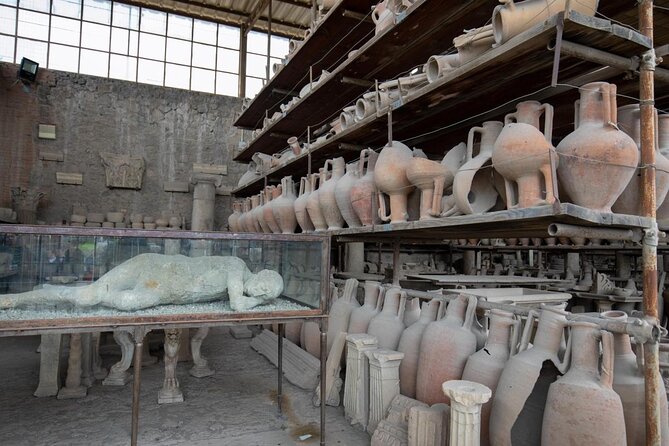
- Pompeii, an ancient Roman city, was buried under volcanic ash from Mount Vesuvius in 79 AD, preserving a remarkable time capsule of everyday life in the Roman era.
- The excavation of Pompeii’s remarkably well-preserved ruins provides a glimpse into the advanced engineering, urban planning, and cultural practices of the ancient Romans.
- Artifacts, such as carbonized loaves of bread, oil lamps, and graffiti, offer insights into the mundane aspects of daily life in Pompeii before its tragic destruction.
- Guided tours of the Pompeii excavation site allow visitors to explore the haunting beauty of the city’s ruins and encounter poignant plaster casts of the eruption’s victims.
- The story of Pompeii’s destruction and the preservation of its cultural treasures, including exquisite frescoes and mosaics, offer a profound reflection on the fragility of human existence.
Exploring the Ruins of Pompeii
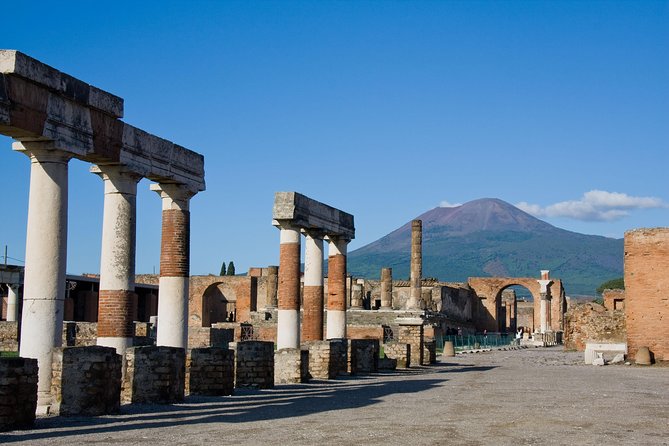
Stepping into the ancient city of Pompeii, visitors are immediately transported back in time. The remarkably preserved ruins offer a glimpse into the daily lives of the Romans.
Wandering through the winding streets, one can admire the well-preserved buildings, including the grand amphitheater, the Forum, and the baths. The colorful frescoes adorning the walls provide a vivid glimpse into Pompeii’s vibrant past.
Visitors can explore the ruins at their own pace, marveling at the ingenuity of the city’s infrastructure and the resilience of its people.
From the iconic Mount Vesuvius in the distance to the poignant casts of the victims, Pompeii’s haunting beauty leaves a lasting impression on all who explore its captivating ruins.
You can also read our reviews of more city tours in Pompeii
Discovering Preserved Roman Architecture
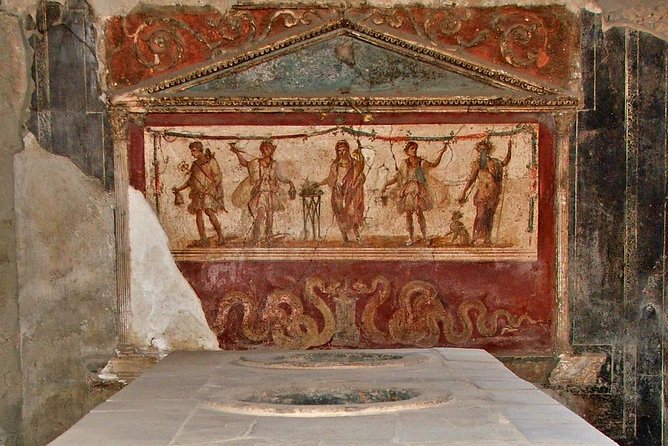
One of the most captivating aspects of exploring Pompeii is the remarkably well-preserved Roman architecture that transports visitors back in time.
The city’s streets, buildings, and public spaces offer a unique glimpse into the daily lives of ancient Romans. Visitors can wander through the remains of grand villas, ornate theaters, and bustling marketplaces, marveling at the intricate details and advanced engineering that defined Pompeii’s urban landscape.
From the iconic amphitheater to the elaborate baths, the preserved structures provide an unparalleled opportunity to take in the architectural legacy of the ancient world.
This remarkable preservation, a result of the catastrophic volcanic eruption that buried Pompeii in 79 AD, allows modern travelers to step into the past and experience the grandeur of a lost civilization.
Unearthing Everyday Life in Pompeii
Pompeii’s daily rhythms come to life through the city’s remarkably well-preserved artifacts, revealing the mundane yet captivating details of ancient Roman life. Excavations have unearthed a treasure trove of objects, from household items and personal belongings to tools and artwork, providing a window into the quotidian experiences of Pompeii’s inhabitants. The following table showcases a glimpse of these discoveries, highlighting the everyday nature of Pompeii’s past:
| Item | Usage | Significance |
|---|---|---|
| Carbonized Loaves of Bread | Food Staple | Reveals Pompeian Culinary Practices |
| Oil Lamps | Lighting | Illuminated Homes and Workspaces |
| Graffiti | Communication | Preserved Dialogue of Ancient Romans |
| Bakery Tools | Food Production | Showcased Local Industry and Commerce |
| Frescoes | Decoration | Captured Artistic Expressions of the Time |
These artifacts offer a tangible connection to the lives of Pompeii’s residents, allowing modern-day visitors to enjoy the vibrant tapestry of the ancient city.
Guided Tour of the Excavation Site

A guided tour offers visitors the chance to explore the well-preserved excavation site of Pompeii, immersing them in the captivating history of this ancient Roman city.
Led by knowledgeable guides, the tours cover the key highlights, from the impressive architecture to the poignant plaster casts of victims. Visitors can wander the streets, marvel at the vibrant frescoes, and gain a deeper understanding of daily life in Pompeii before its tragic demise.
The tours are accessible, with options for wheelchair users and stroller-friendly paths.
Whether you’re interested in archaeology, history, or simply exploring a unique UNESCO World Heritage site, a guided tour of Pompeii is an enriching and unforgettable experience.
Journey Through the City’s History
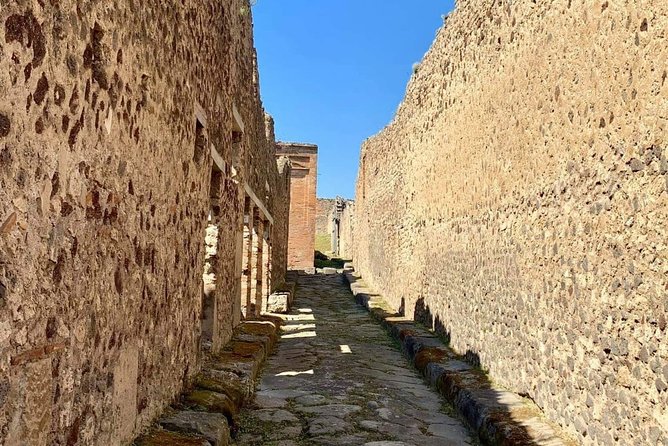
As visitors explore the well-preserved excavation site of Pompeii, they embark on a captivating journey through the city’s history.
Guided tours bring the past to life, allowing visitors to imagine the bustling streets, thriving markets, and grand public buildings that once stood here.
Meticulously preserved artifacts, from intricate mosaics to ornate sculptures, offer glimpses into the daily lives and cultural traditions of Pompeii’s ancient inhabitants.
Visitors can even see the haunting casts of those who perished in the eruption, a poignant reminder of the city’s tragic end.
Through this immersive experience, Pompeii’s story unfolds, transporting visitors back in time to a civilization frozen in time.
- Pompeii Small Group Tour With an Archaeologist
- Pompeii and Herculaneum Small Group Tour With an Archaeologist
- Small Group Guided Tour of Pompeii Led by an Archaeologist
- Sharing Tour of Pompeii
- Pompeii Skip-The-Line Small Group Tour With Archaeologist Guide
- Visit in Pompeii – Pompeii Private Tour With Ada
Experiencing Pompeii’s Volcanic Destruction

How does one truly grasp the scale of Pompeii’s catastrophic demise? The ill-fated city was buried beneath layers of volcanic ash and debris when Mount Vesuvius erupted in 79 AD.
Visitors can witness firsthand the haunting remnants of Pompeii’s tragic end. Wandering through the eerie, abandoned streets, one can imagine the terror that gripped the inhabitants as the deadly pyroclastic flows surged through the city.
The plaster casts of victims, frozen in their final moments, evoke a visceral sense of the city’s devastation. Exploring the well-preserved ruins, from grand villas to humble homes, offers a poignant glimpse into the lives so abruptly extinguished by the volcano’s wrath.
Experiencing Pompeii’s volcanic destruction is a sobering, yet profound, encounter with history.
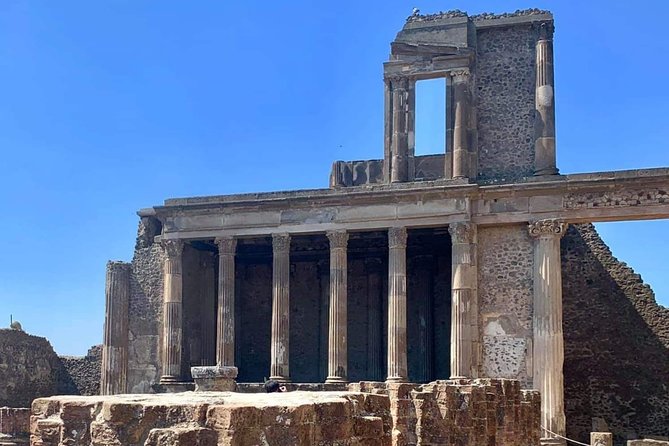
Across the ancient street network of Pompeii, visitors can explore the intricate pathways that once bustled with the rhythms of daily life. Walkways were paved with large blocks of stone, and stepping stones were installed to help pedestrians navigate the streets during rainy weather. Interestingly, the roads were designed with grooves to allow rainwater drainage, showcasing the Pompeiians’ advanced urban planning. To better understand the layout, visitors can reference this helpful table:
| Street Feature | Description |
|---|---|
| Stepping Stones | Raised blocks to cross streets during floods |
| Grooved Pavement | Allowed rainwater runoff |
| Cobblestones | Paved with large stone blocks |
This ancient street system offers a glimpse into the vibrant past of Pompeii.
Uncovering Artistic and Cultural Treasures
Beyond the ancient street network, Pompeii’s excavations reveal a captivating mosaic of artistic and cultural treasures.
Visitors can marvel at the exquisite frescoes, mosaics, and sculptures that once adorned the city’s public buildings and private homes. The Villa of the Mysteries boasts some of the most well-preserved and breathtaking frescoes, depicting scenes from the Dionysian mysteries.
The Lupanar, or ancient brothel, offers a unique glimpse into the social and cultural dynamics of Pompeii’s past.
Exploring these artifacts and sites provides a tangible connection to the daily lives and rituals of Pompeii’s inhabitants, offering a profound insight into the city’s rich heritage.
Frequently Asked Questions
What Is the Meeting Point for the Pompeii Tour?
The meeting point for the Pompeii tour is Pompei-porta Marina – scavi, 80045 Pompei, Metropolitan City of Naples, Italy, located in front of the Circumvesuviana train station at the Pompeii Scavi site.
What Is the Duration of the Pompeii Tour?
The Pompeii tour operates from 1/10/2024 to 1/9/2025 and 1/10/2025 to 1/9/2026, with a duration of 4.5 hours, running from 9:30 AM to 2:00 PM daily.
Are There Any Accessibility or Health Requirements for the Tour?
The Pompeii tour is wheelchair and stroller accessible, and it’s located near public transportation. Moderate physical fitness is required, and guests can’t have serious medical conditions like heart problems.
What Is the Cancellation Policy for the Pompeii Tour?
The Pompeii tour offers free cancellation up to 24 hours before the experience begins. Travelers can reserve now and pay later, ensuring flexibility with their plans. The tour also provides a lowest price guarantee.
What Is the Price per Group for the Pompeii Tour?
The Pompeii tour costs $220.83 per group of up to 6 people. It offers a free cancellation policy up to 24 hours before the experience starts, and there’s a lowest price guarantee.
Sum Up
Pompeii’s frozen-in-time ruins offer a profound glimpse into the vibrant past of this ancient Roman city. Visitors can wander its streets, marvel at the well-preserved architecture, and connect with the poignant stories of its people, forever altered by Vesuvius’ catastrophic eruption. This unique archaeological site invites us to reflect on the fragility of life and the lasting legacy of a civilization lost to time.
More City Tours in Pompeii
- Discover Pompeii on This Guided Walking Tour of the Buried City
- Life and Death of the Roman City of Pompeii With a Local Guide. Private Tour
- The Beautiful Pompeii, Two-Hour Tour to Discover the Hidden Places of the City
- 5-Hour Pompeii Ruins & Naples City Center Private Walking Tour
- Naples Shore Excursion: Naples City and Pompeii Half Day Sightseeing Tour
More Tour Reviews in Pompeii
Not for you? Here's more nearby things to do in Pompeii we have reviewed
- Pompeii Virtual Museum Entrance Ticket
- Full Day Capri Tour from Pompeii by Small Ferry Boat
- Pompeii Guided Tour with Skip-the-Line Entry
- Pompeii private tour with expert guide in archaeology
- Private Guided Tour of Pompeii Excavations
- The charm of Pompeii and Herculaneum.Private Tour with Official Guide
- Pompeii Tour with experienced guide
- Private Ravello Walking Tour & Wine Tasting
- Private Transfer from Naples to Positano
- Pompeii shared tour (small groups) – 2 hours
- Guided Private Tour in Pompeii
- 2 Hours Guided Pompeii Tour with Skip The Line Ticket Entry
